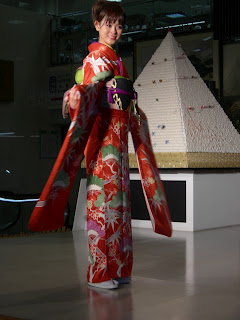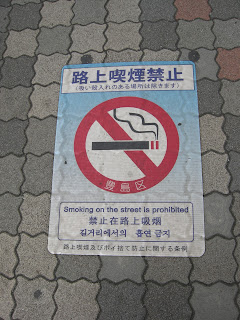As I said, Arimatsu was at one time THE shibori centre of Japan. The town's textile heritage is celebrated at every opportunity. Our first encounter with the beautiful designs was at the railroad station. Glass panels in the railing surrounding the station were sandblasted with various shibori designs. Each panel was accompanied by a small plaque giving the name of the specific design etched on the glass.
A small shopping centre is located next to the train station. In the middle of the parking lot is the Shibori Tower, a sculpture made of glass panels that also feature various shibori patterns. I suspect the "balls" between the various paneled cubes represent knots while the cubes themselves represent the stitches one might use to create some of the designs.
I suspect the tower is more impressive at night when the cubes are lit from within, thereby showing the designed panels to greater effect.
The town was relatively quiet when we were there, due to the fact that much was closed because of the New Year's holiday. Fortunately, there is a wonderful museum (Arimatsu-Narumi Shiborikaikan) devoted to the preservation and dissemination of information regarding this amazing textile art. http://www.shibori-kaikan.com/kaikan-e.html Not only was the museum opened, but it served as a fabulous introduction to all things shibori. Intricate hangings lined the staircase leading to the museum ...
There were also fascinating displays of historic textiles - including some recreations of samurai uniforms, uniquely dyed kimono, and examples of the various stages of some shibori techniques (fabric before knotting, knotting, after dyeing, when knots are removed). In each case, it was amazing how much dye could be resisted with even the tiniest of knots.
The above kimono (last photo) is the recreation of a famous painting of the main street of Arimatsu at the height of the shibori trade. Everything that looks like a line is, in fact, a series of stitches or knots. Most shop signs we saw around town were made in a similar fashion with various shibori techniques replacing better known means of creating signage.
One of the highlights of our visit to the Arimatsu-Narumi Shiborikaikan was an encounter with one of Japan's famous "living treasures". In this case, it was a 90+-yr-old woman named Tomeko Honma who is the only living person still creating textiles using a unique/specific technique.

Nearly deaf, she is a very funny person because she doesn't answer your questions so much as talk about what she wants to talk about - and she has a nice sense of humour that comes through despite our language barrier! Her hands moved in a blur! Check out her technique in this video http://www.youtube.com/watch?v=7ZSpxj4Ywg4&feature=relmfu (note: the video was filmed about five years ago and is in Japanese). Tomeko Honma is the third to have her technique explained in the video.
Yoriko and I weren't content to simply watch others enjoy the creative process. We took a mini workshop that had us stitching and tying a pre-printed handkerchief. Our 80+-year-old instructor learned the techniques in the 2nd grade, so was understandably a tad impatient with my clumsy technique. I sew one stitch at a time. She does several in a single pull of the thread by moving the needle back and forth between her thumbnails - Yoriko said that is how she was taught as well (also in the 2nd grade).
 | ||||
| The happy student |
 | ||||||||||||
| Knots tied (including two by Tomeko Honma), the piece is ready for dyeing. |
My favourite Arimatsu souvenir? Hands down it's the silk scarf that I call "sea urchin" because of how it looks when sitting on my dresser. It's essentially a tube of fabric that has been tied and then steamed to hold its shape. As a scarf, it's surprisingly warm. Yoriko thought it would also make a funky hairband/hat:
The lovely Yoriko arranged for us to attend two other mini workshops, one in Tokyo and the other in Kyoto. Both were printing classes, but with very different results.
The Tokyo-based workshop took place at the Shinjuku Mini Museum & Dye Village - Futaba En (http://www.futaba-en.jp/eng/index.html). We worked on pre-printed heavy cotton fabric, and used 10 different stencils and five different colours. The dye was painted on by means of a deer-hair brush that was held at the top of the bristles rather than the top of the brush.
 |
| Left: pre-printed cloth with registration marks at top and bottom edges. Right: pre-inked stencil. |
 |
| Yoriko and others demonstrating good brush technique. |
 |
| Checking my work between stencils. Don't I look fetching in Yoriko's father's old shirt? |
 |
| Work in progress. One stencil for light blue, another for dark. One stencil for light gold, another for dark, etc. |
 |
| Couldn't be more pleased with finished result! Looks great on my kitchen table. |
In Kyoto, we were delighted to find a wide range of textile techniques showcased at the Nishijin Textile Center (fyi, the Nishijin district is known for producing the best silk textiles in Japan). Here we encountered a master artist preparing an ikat warp - he used pieces of bicycle inner tubes for wrappers (placed clear plastic on either side of the tubing to prevent the rubber from blackening the white threads).
We also watched a lacquerware painter, another man applying gold leaf and gutta-like gold paint to obi cloth, and weavers working on two-shaft variations of the local obi textiles. There was also a woman demonstrating how to make artificial flowers from silk cocoons. Also took in a kimono fashion show (note that the pyramid-shaped stage props are covered in silk cocoons).
While in Kyoto we made a couple of other exciting textile-focused discoveries. Both places were encountered while we were en route to Kiyomizu-dera. The first thrill (for me at least) was stumbling upon Hinaya, the shop owned by Akihiko Izukura (http://akihikoizukura.com/). Several years ago I interviewed Mr. Izukura for Fiber Arts magazine, and was to have taken a dye workshop with him but couldn't attend as it took place on the weekend after my father died. Sadly, Mr. Izukura was away teaching in Hawaii when Yoriko and I entered the shop, but we were well entertained by his staff. One took us upstairs where we bought several remnants (by weight) - a nice consolation as yardage averaged $30+/10 inches! Since I already own a shawl (a gift from the artist), I wasn't too concerned about not buying any of the ultra-expensive clothes. But I drooled just the same.
As we came closer to the temple, we came upon a dye house located along Chawanzaka aka Teapot Road. I wish I had written down the name of the little shop as the owner/designer grew his own indigo and persimmon for dye as he didn't trust commercial sources. I especially liked one wall hanging that looked like water, but it was large, framed, and cost several thousands of dollars. At least I could admire it for a while.
Before leaving Kyoto, Yoriko and I took in another mini workshop. Like the one at Futaba En, this one focused on stenciling. However, this go 'round we started out with a plain white hankie that we then stenciled with various colours of dye/ink. Otherwise, the technique was very similar to the Futaba En experience. Must say I was rather pleased when the instructor commented on my "good technique". Guess just watching folks play is boring work, so he applied "the magic" - the white dye/ink that made the rest of the colours pop.
Of course, no journey to Kyoto would be complete without a geisha sighting or two. Gion, the city's entertainment district is the best place to see them, but we were there too early for much nightlife activity. We spotted a couple of geisha, but I didn't want to take their photo without their permission. Finally happened upon this young woman who was just returning from a job. Yoriko asked her companion (mother? boss? manager?) for permission as she knew the young woman couldn't answer for herself. Yoriko also informed me that the western use of the word "geisha" is not really appropriate as it is used as an umbrella term for traditional female entertainers. And entertainment does not equal sex! Today it's really more about preserving traditional performing arts. Apparently there are many different names for these women, depending on what it is they actually do. For example, a musician is called something quite different from a dancer. In addition, there is a ranking system within each area of expertise. It's all rather complicated. I think Yoriko said this woman was likely a "maiko" or apprentice.
An added treat during our visit to Kyoto was spending an evening with Chisako Hisamatsu, a former member of the Silk Weaving Studio on Granville Island. A few years back, Chisako and her husband Paul returned to Kyoto. In addition to weaving, Chisako teaches English at a local university, as does Paul. I didn't want to take any photos in their house as I wanted to respect their privacy, but you can see some of her weaving on the Silk Weaving Studio website at http://www.silkweavingstudio.com/chisako.html I'm looking forward to seeing Chisako again this fall when she will be in Vancouver for an exhibition of her work as well as being workshop leader/lecturer during the Maiwa Symposium. Here's a photo of Yoriko, Chisako and me at a wonderful little Kyoto izakaya.
The wonderful thing about being in Japan and having a fondness for all things textile was finding so many things of interest. Everywhere we went there was a new technique or material to be seen. In Nara, I was surprised to find so much linen (sometimes called hemp so not really sure which it is, but its beautiful). Unlike the fine Irish linen that I know so well, this variety tended to be much coarser so added an interesting texture to woven goods. I purchased a beautiful wall hanging from Mafu Okai (a shop specializing in Nara Sarashi, as the textile is known - http://www.mafu-okai.com/noren.htm). My hanging is dyed with the fermented juice of unripened persimmons aka kakishibu. The resulting colour is a beautiful warm rose brown. Check out this web page to see some folks working with the fibre. http://www.facebook.com/media/set/?set=a.389583031909.177764.126060191909&type=3








































